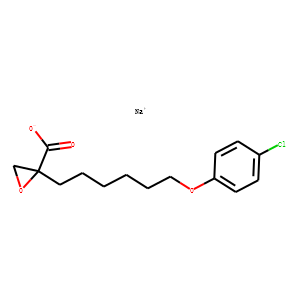| Reference | 1. FASEB J. 2002 Oct;16(12):1688-90. Epub 2002 Aug 21.
<br>
Etomoxir-induced increase in UCP3 supports a role of uncoupling protein 3 as a
mitochondrial fatty acid anion exporter.
<br>
Schrauwen P(1), Hinderling V, Hesselink MK, Schaart G, Kornips E, Saris WH,
Westerterp-Plantenga M, Langhans W.
<br>
Author information: <br>
(1)Nutrition and Toxicology Research Institute Maastricht, Department of Human
Biology, Maastricht University, 6200 MD Maastricht, The Netherlands.
[email protected]
<br>
The physiological function of human uncoupling protein-3 is still unknown.
Uncoupling protein-3 is increased during fasting and high-fat feeding. In these
situations the availability of fatty acids to the mitochondria exceeds the
capacity to metabolize fatty acids, suggesting a role for uncoupling protein-3 in
handling of non-metabolizable fatty acids. To test the hypothesis that uncoupling
protein-3 acts as a mitochondrial exporter of non-metabolizable fatty acids from
the mitochondrial matrix, we gave human subjects Etomoxir (which blocks
mitochondrial entry of fatty acids) or placebo in a cross-over design during a
36-h stay in a respiration chamber. Etomoxir inhibited 24-h fat oxidation and fat
oxidation during exercise by approximately 14-19%. Surprisingly, uncoupling
protein-3 content in human vastus lateralis muscle was markedly up-regulated
within 36 h of Etomoxir administration. Up-regulation of uncoupling protein-3 was
accompanied by lowered fasting blood glucose and increased translocation of
glucose transporter-4. These data support the hypothesis that the physiological
function of uncoupling protein-3 is to facilitate the outward transport of
non-metabolizable fatty acids from the mitochondrial matrix and thus prevents
mitochondria from the potential deleterious effects of high fatty acid levels. In
addition our data show that up-regulation of uncoupling protein-3 can be
beneficial in the treatment of type 2 diabetes.
<br><br>
2. Toxicol Sci. 2002 Jul;68(1):93-101.
<br>
Etomoxir-induced oxidative stress in HepG2 cells detected by differential gene
expression is confirmed biochemically.
<br>
Merrill CL(1), Ni H, Yoon LW, Tirmenstein MA, Narayanan P, Benavides GR, Easton
MJ, Creech DR, Hu CX, McFarland DC, Hahn LM, Thomas HC, Morgan KT.
<br>
Author information: <br>
(1)Department of Microbiology, Pathology and Parasitology, North Carolina State
University, Raleigh 27606, USA. [email protected]
<br>
Although they are known to be effective antidiabetic agents, little is published
about the toxic effects of carnitine palmitoyltransferase-1 (CPT-1) inhibitors,
such as etomoxir (ET). These compounds inhibit mitochondrial fatty acid
beta-oxidation by irreversibly binding to CPT-1 and preventing entry of long
chain fatty acids into the mitochondrial matrix. Treatment of HepG2 cells with 1
mM etomoxir for 6 h caused significant modulations in the expression of several
redox-related and cell cycle mRNAs as measured by microarray analysis.
Upregulated mRNAs included heme oxygenase 1 (HO1), 8-oxoguanine DNA glycosylase 1
(OGG1), glutathione reductase (GSR), cyclin-dependent kinase inhibitor 1A (CDKN1
[p21(waf1)]) and Mn+ superoxide dismutase precursor (SOD2); while cytochrome P450
1A1 (CYP1A1) and heat shock 70kD protein 1 (HSPA1A) were downregulated. Real time
quantitative PCR (RT-PCR) confirmed the significant changes in 4 of 4 mRNAs
assayed (CYP1A1, HO1, GSR, CDKN1), and identified 3 additional mRNA changes; 2
redox-related genes, gamma-glutamate-cysteine ligase modifier subunit (GCLM) and
thioredoxin reductase (TXNRD1) and 1 DNA replication gene, topoisomerase IIalpha
(TOP2A). Temporal changes in selected mRNA levels were examined by RT-PCR over 11
time points from 15 min to 24 h postdosing. CYP1A1 exhibited a 38-fold decrease
by 4 h, which rebounded to a 39-fold increase by 20 h. GCLM and TXNRD1 exhibited
13- and 9-fold increases, respectively at 24 h. Etomoxir-induced oxidative stress
and impaired mitochondrial energy metabolism were confirmed by a significant
decrease in reduced glutathione (GSH), reduced/oxidized glutathione ratio
(GSH/GSSG), mitochondrial membrane potential (MMP), and ATP levels, and by
concurrent increase in oxidized glutathione (GSSG) and superoxide generation.
This is the first report of oxidative stress caused by etomoxir.
<br><br>
3. Mol Cell Biochem. 2002 Mar;232(1-2):57-62.
<br>
Differential effects of etomoxir treatment on cardiac Na+-K+ ATPase subunits in
diabetic rats.
<br>
Kato K(1), Lukas A, Chapman DC, Rupp H, Dhalla NS.
<br>
Author information: <br>
(1)Institute of Cardiovascular Sciences, St Boniface General Hospital Research
Centre and Department of Physiology, Faculty of Medicine, University of Manitoba,
Winnipeg, Canada.
<br>
Etomoxir, an inhibitor of mitochondrial carnitine palmitoyltransferase-1, is
known to attenuate the changes in myosin isoforms and sarcoplasmic reticular
function that occur in diabetic rat hearts. In the present study, we tested the
hypothesis that etomoxir also prevents the diabetes-induced depression of
sarcolemmal (SL) Na+-K+ATPase activity by differentially affecting its alpha and
beta-subunit levels. Streptozotocin-induced diabetes was associated with a
decreased in alpha2-, alpha3-subunit levels, whereas the alpha1-and
beta1-subunits were unchanged. Treatment of diabetic rats for 4 weeks with
etomoxir (8 mg/kg/day) increased the alpha1-subunit levels, but failed to prevent
the decrease in alpha2- and alpha3-subunit levels. In euglycemic control rats,
etomoxir increased the alpha1-subunit protein level per g heart weight, but did
not alter the alpha2-, alpha3- and beta1-subunit levels. The large decrease in
Na+-K+ ATPase activity per g heart weight in diabetic rats was prevented by
etomoxir, which suggests that the increased alpha1-subunit levels seen with this
drug compensated for the decreased alpha2- and alpha3-subunit levels. The SL
yield was also increased by etomoxir in euglycemic rats in proportion to the
higher alpha1-subunit level, which resulted in an unchanged alpha1-content when
expressed per mg SL protein; however, the alpha2- and beta1-subunit levels were
reduced (p < 0.05). The depressed alpha2- and beta3 subunit levels of diabetic
rats were associated with reduced mRNA abundance. However, no increase in
alpha1-subunit mRNA abundance was seen in the etomoxir treated rats, which
suggests that possibly post-transcriptional mechanisms are occurring in these
hearts.
<br>
|

